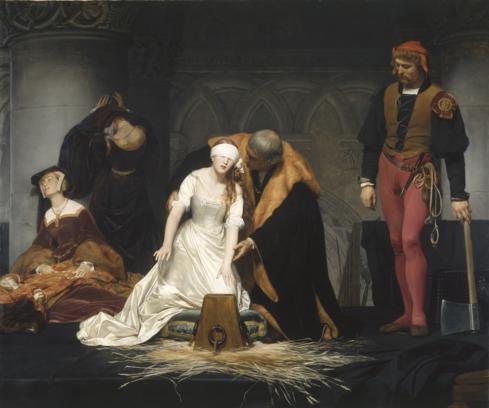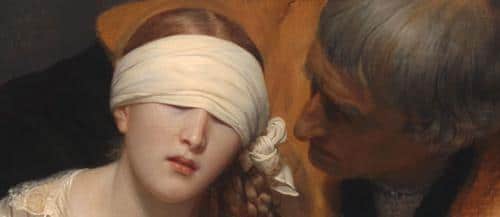Next week Friday is the anniversary of Lady Jane Grey’s execution which took place on the 12th February 1554. Lady Jane Grey, “The Nine Day Queen”, was only around 16 or 17 when she was executed for high treason after Mary I successfully claimed the throne, bringing Jane’s reign to an end after just a week. Her youth and vulnerability is emphasised in Paul Delaroche’s beautiful painting “The Execution of Lady Jane Grey”, which was painted in 1833.

Painting History: Delaroche and Lady Jane Grey
24th February – 23rd May 2010
Sainsbury Wing, Admission Charge
If you want to see Delaroche’s “The Execution of Lady Jane Grey” with your own eyes, and also enjoy his preparatory drawings and other famous works, you can go to the special “Delaroche and Lady Jane Grey Exhibition” which is taking place at the National Gallery between the 24th February – 23rd May 2010 in the Sainsbury Wing. Here is the National Gallery Press Release:-
“I am assured that I shall, for losing of a mortal life, win an immortal life.” (Lady Jane Grey, February 1554)
Since its rediscovery in 1973 and first exhibition at the National Gallery two years later, Paul Delaroche’s The Execution of Lady Jane Grey, 1833, has become one of the nation’s best-loved paintings. For the first time, Painting History examines this iconic masterpiece in the context of Delaroche’s great historical paintings, particularly the poignant scenes from English history which made his reputation.
The exhibition features seven major international loans of paintings by Delaroche including The Princes in the Tower, 1830 and Young Christian Martyr, 1854–5 (both Louvre) and Strafford on his way to Execution, 1835 (private collection).
Displayed alongside are Delaroche’s expressive preparatory drawings for Lady Jane and a selection of comparative paintings and prints by his contemporaries, including Eugène Lami, Claude Jacquand and François-Marius Granet.
Monumental in scale, poignant in subject matter and uncanny in its realism, Delaroche’s depiction of the 17-year-old, who was Queen of England for just nine days, created a sensation when first unveiled at the Paris Salon of 1834. It appeared to usher in an entirely new form of painting. But what inspired a French artist in the 1830s to depict the final moments of a 16th-century English queen? In post-revolutionary France, artists began to combine monarchist sympathies with a Romantic interest in English literature and history. After the Battle of Waterloo in 1815, a generation of artists including Delaroche, Bonington and Lami found inspiration in Shakespeare, Byron and, above all, Walter Scott. Yet for Delaroche, English history provided a still more powerful muse. In a society deeply scarred by the violent upheavals of the French Revolution, English history presented remarkable parallels with recent events in French history – particularly the execution of Lady Jane Grey, the death of the princes in the Tower, the English Civil War and the regicide of Charles I.
Delaroche (1797–1856) first visited England and possibly Scotland in 1822 but returned to London five years later to prepare for his work on The Princes in the Tower, 1830 (Louvre). It is probable he visited the Tower of London itself, an experience which may have moved him to develop his two further Tower compositions: The Execution of Lady Jane Grey, 1833 (National Gallery, London) and Strafford on his Way to Execution, 1835 (private collection).

Like many of his peers, Delaroche showed a keen interest in the themes of usurpation and martyrdom. In Cromwell
and Charles I, 1831 (Musée des Beaux-Arts, Nîmes), the artist depicts a sombre Cromwell contemplating the corpse of
his enemy, the executed Charles. Always veiled in myth, the death of Lady Jane Grey (1537–1554) gave Delaroche his
most poignant symbolic subject. Grey inherited the English crown amid a bitter political crisis following the death of
Edward VI on 6 July 1553. Her reign ended on 19 July when Mary, her Catholic cousin and rival to the throne, led a
successful counter-coup. Together with her young husband, Jane stood trial for treason. They were sentenced to death and Jane was re-imprisoned in the Tower, where she firmly resolved to become a Protestant martyr. She was beheaded on 12 February 1554. The events of that day have been fiercely debated ever since.
In Delaroche’s depiction, Jane is shown blindfolded and feeling for the executioner’s block. While emotionally the most compelling, this version of events owes more to 16th-century propaganda than to historical fact. Within six months of Jane’s death, her Protestant allies had her reinvented as an innocent martyr and victim of Catholic
tyranny. In London, a dossier of doctored papers was soon in circulation, complete with the pathos of her groping
for the block. Capturing the psychological moment of greatest intensity, Delaroche gave the Lady Jane myth an irresistible and seemingly unshakeable appeal. Appearing from the shadows in a dress of startling virgin white,
she becomes the very apotheosis of female innocence.
Delaroche’s image was a striking reminder, for those with memories of recent French history, of the fates of Louis XVI, Marie-Antoinette and the Dauphin. Delaroche undoubtedly made such associations in his own mind, as is suggested by a sheet of studies in which thumbnail drawings for Lady Jane appear alongside a composition of the Dauphin and his sister, before July 1830 (Louvre). Towards the end of his life, Delaroche completed a startling memorial to France’s executed queen in Marie-Antoinette before the Tribunal, 1851 (The Forbes Collection, New York).
Throughout the exhibition, Painting History examines the singular intensity of Delaroche’s historical paintings in light of his close relationship with the theatre. From the 1820s, there was an increasing tendency in French theatre to draw on pictorial forms, and for plays to be divided into so-called ‘tableaux’ as well as acts. This new kind of theatre had a profound influence on Delaroche, who was also keenly receptive to the spatial possibilities offered by stage craft. Meanwhile, his own work lent itself to dramatic recreation and on several occasions, his paintings were represented on the stage, including Lady Jane Grey and The Princes in the Tower. By the time he was painting Lady Jane, Delaroche had also become romantically involved with Mademoiselle Anaïs, an actress now thought to be his model for the queen. A newly discovered portrait of Anaïs in coloured chalk, 1832 (private collection) is displayed here for the first time.
The exhibition also demonstrates how French and British artists such as Edouard Cibot (Anne Boleyn in the
Tower of London, shortly after her Arrest, 1835, Musée Rolin, Autun), Jean-Léon Gérome (The Execution of Marshal Ney, 1868, Museums Sheffield) and Jean-Paul Laurens (The Hostages, 1896, Musée des Beaux-Arts, Lyon) continued to work in a manner directly inspired by Delaroche’s pioneering depictions.
Admission and Open Hours
Press view: 23 February 2010, 10.30am–1.30pm
Open to public: 24 February 2010 – 23 May 2010, Daily 10am–6pm, Friday until 9pm
Last admission 5.15pm (8.15pm Friday)
Admission
Enter by the Sainsbury Wing Entrance.
Full price £8
Senior/Concession/Disabled visitors £7
Carers FREE
Job seeker/Student/Art Fund £4
Family (2 adults and ≤4 children) £16
Under 12s FREE
Season Ticket £20
Senior/Disabled Season £18
Job seeker/Art Fund/ Student Season £10
For advance tickets to Painting History please visit www.nationalgallery.org.uk (booking fee).
You can also book tickets by post and in person from the Gallery.
For public information, please contact 020 7747 2885 or email information@ng-london.org.uk
While you’re at the National Gallery, you can also see the Room 1 exhibition “A Masterpiece Recovered: Delaroche’s Charles I Insulted” (admission free) and the gallery’s collection of over 2,300 works, including a host of fabulous Renaissance art.
Images used with permission of the National Gallery.